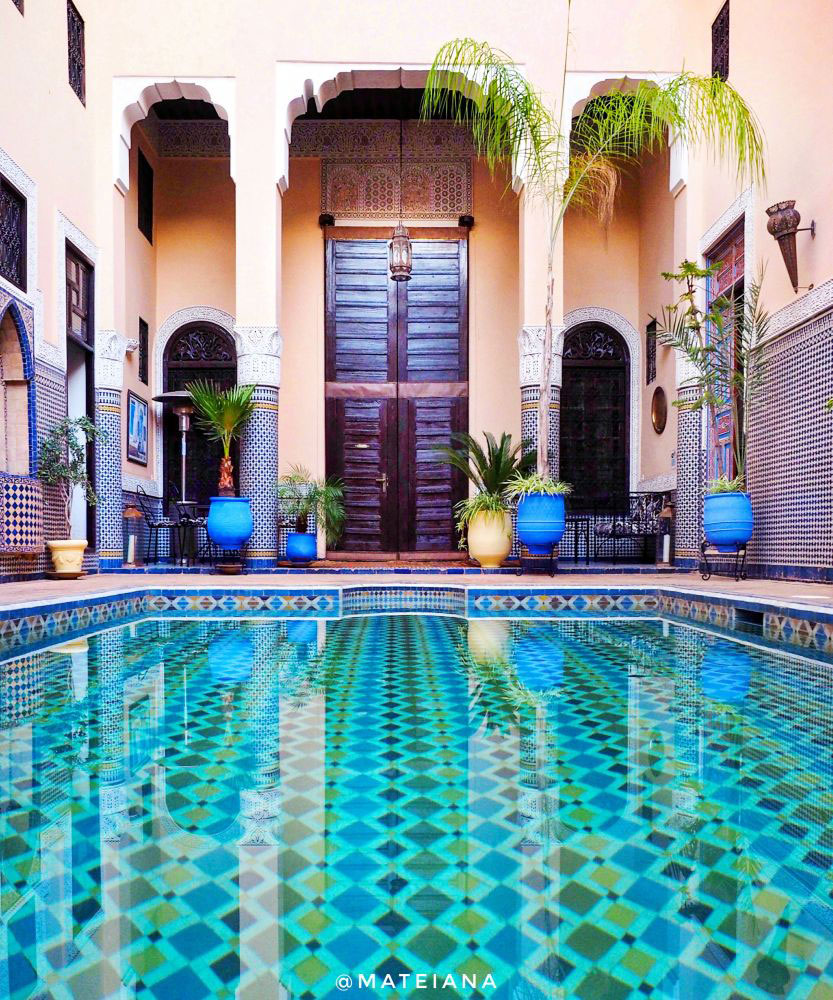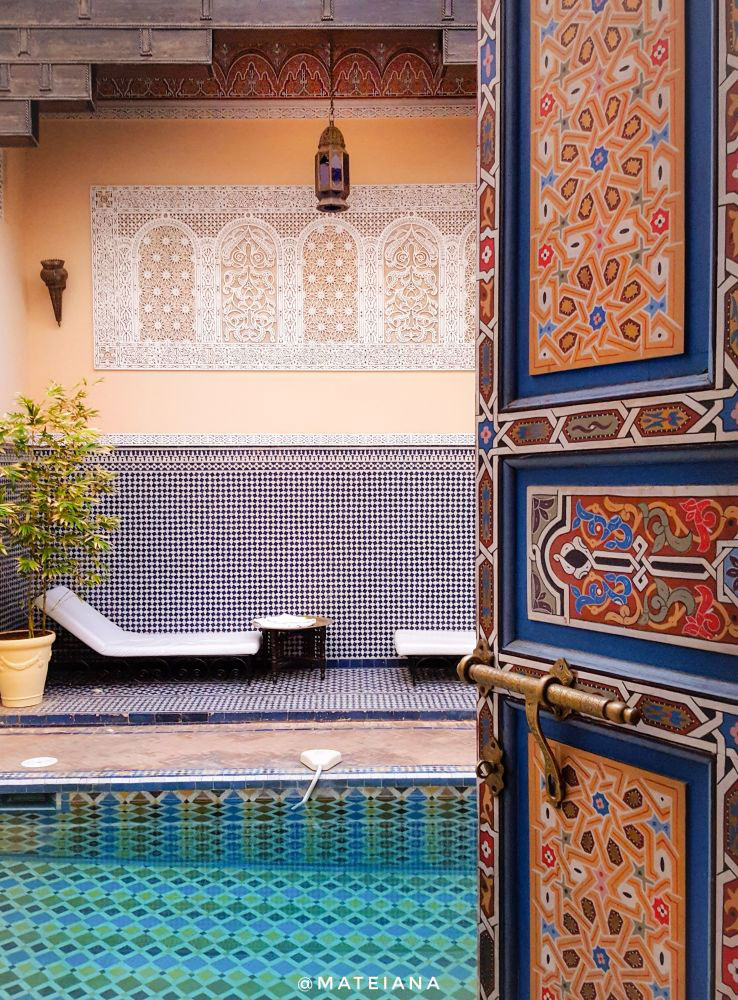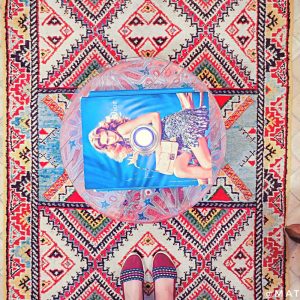Staying in Moroccan Riads was the most rewarding hotel experience I ever had.
These traditional Moroccan houses offer the warmest atmosphere a traveler can hope for in a hotel, not to mention great interior design, cozy cushions, gorgeous mosaics, and that oriental scent of incense sticks that makes you feel at home in a heartbeat.
But there’s more to Moroccan Riads than what first meets the eye – they give you a crash course in hospitality, and they make you feel more welcomed and pampered than you have ever been in your life. Well, that’s something to look forward to when visiting Morocco, isn’t it?
Moroccan Riads are architectural gems
Moroccan architecture is all about amazing interiors and humble exteriors, and this contrast leaves you in awe each time you step into a new Riad. The crafts behind their interior design are considered arts, and you’ll surely agree after taking this visual tour of the Moroccan Riads I’ve stayed in.
Each riad has a magnificent interior courtyard, similar to an Andalusian patio. The most beautiful ones also have a small pool at the center, among other gorgeous elements like fountains, mosaics, Berber carpets and an abundance of plants.
Riads at the core of Moroccan families
Riads are at the core of Moroccan families, and they’re built incrementally in order to accommodate a growing family.
They usually have 5 to 11 rooms, and this number is given by the members of the family who built it. Parents build and live on the ground floor, but after children grow up, they extend it, adding the 1st floor. Therefore, wealthy families with many children build the largest Riads.
Also, the second stage of the building brings a slightly crooked upper floor to some of the Riads; and if you think about it, that adds to the authentic feel of these traditional Moroccan houses.
Why you should definitely stay in a Moroccan Riad
Nowadays, the former imperial cities of Morocco get many tourists, so lots of Riads have been opened to the travelers, offering a wonderful Moroccan experience. The owners are usually French people who brought the Riads to their former glory by renovating the old establishments and sometimes adding a pool in the middle of the patio.
One thing to remember, especially when you’re looking to book a Riad is that you’re in for more than just accommodation, it’s a must-have experience when visiting Morocco. That’s because you’ll get lessons in hospitality that you’ll never forget, not to mention the perk of being constantly pampered, which doesn’t happen the same way in 5 stars hotels.
Since my Moroccan Road Trip took me to Fes, Rabat, and Marrakech, I’ll take you on a visual journey of the beautiful Riads I’ve had the pleasure to stay in during my road trip in Morocco.
Riads of Morocco| Where to stay in Fez, Rabat & Marrakech
Riad Fes Baraka – Fez Medina
Samir, the manager of the first Moroccan Riad we stayed in, welcomed us late in the evening with a steaming teapot and three glasses on a silver tray.
Still standing, he raised his right arm in the air and poured the magic mint tea with fascinating precision into the three little glasses on the table, until the bubbly drink was garnished with mint leaves. He then joined us for the serving and began sharing his insights on Fes and asking about what we wanted to visit in Morocco.
This first encounter with Moroccan hospitality was magical! We were the only ones there at the time, and it felt like being a guest in someone’s home.
Riad Fes Baraka was bathing in a warm light, all reflected in the blue mosaic pool at its center, creating a bohemian atmosphere and a sense of mystery.
We woke up early to the song of birds hidden in the palms surrounding the inner courtyard and had a quiet breakfast by the pool.
Before we left for Chefchaouen, I explored the Riad a bit, admiring its wonderful decorations – the zellij (Moroccan mosaics) dressing the columns, windows and walls, the colorful Berber doors, the silky textiles – while taking in the beauty and quietness of this place.
Our room was a fascinating blend of traditional Moroccan motifs, with a tall wood ceiling, and an old Berber door vividly painted in shades of blue. When guests started to come down for breakfast, we left for Chefchaouen.
In the evening, Samir served us a great meal of kefta tajine and Moroccan salads and stayed a bit to chat with us.
And it was then when I realized the main perk of staying in a Moroccan Riad – as a guest, you get this wonderful attention from your host, who’s not only going to tend to your every need but also offer you advice for your trip and great nuggets of insights into the Moroccan culture.
We loved the whole experience at Riad Fes Baraka, but especially its bohemian atmosphere.
*The accommodation costs were higher than your average hotel rate for Fes, around 100€/room/night, breakfast included, but I think it was worth it.
Riad Dar Soufa – Rabat Medina
 The noisy shopping street went quiet once we stepped into Riad Dar Soufa, on a tiny hidden alley in Rabat Medina.
The noisy shopping street went quiet once we stepped into Riad Dar Soufa, on a tiny hidden alley in Rabat Medina.
Our host welcomed us with a big smile, and she quickly fetched a tray with mint tea and delicious cookies, even if we were in a hurry to catch the sunset by the waterfront.
“It’s tradition”, she said while pouring the sweet and hot tea into our glasses, suggesting there was no way we could have skipped this Moroccan hospitality ritual.
That moment I realized Tahir Shah was in no way exaggerating the importance of traditions in Moroccan culture when describing it in his entertaining book – “The Caliph’s House: A Year in Casablanca”.
Our smiling host led us to a beautiful room in the Riad, and we discovered the reason why most interior designers love Morocco. The white room with indigo accents is a minimalist’s dream! Every element in the room was carefully chosen not only to embellish but also to serve a clear purpose. Still, even in this newly renovated room, the main Moroccan motifs are honored – the tall wooden door and ceiling, the minimal bathroom design, the Moroccan lamps, and the traditional textiles.
In the morning, our host prepared the best breakfast we had during our stay in Morocco, going the extra mile by adding lots of fruits and bread to the traditional Moroccan breakfast. We served it on the sunny rooftop terrace and then left to discover Rabat.
Since we only spent a night in Rabat, we weren’t keen on having a pool, so Riad Dar Soufa was a good choice.
*This was also the most affordable Riad in Morocco, 60€/room/night, breakfast included.
While researching for the best places to stay in Morocco, I noticed that Riads with a pool tend to be 30% more expensive than the others. Also, a great interior design also makes the price per night go up by 30%, so you might want to take that into account when choosing your riad in Morocco.
Riad Melhoun & Spa Marrakech – Marrakech Medina
Getting through the tens of mopeds roaming the streets of Marrakech was a challenge, but when we entered our Riad in Marrakech it was like stepping into a calm oasis.
Berber music in the background, the aroma of spicy incense sticks, and the calm atmosphere that welcomed us at Riad Melhoun & Spa were exactly what we needed to relax after our long day.
Of course, we had mint tea upon arrival and then we were taken to our cozy beautiful room.
Our room at Riad Melhoun & Spa was tastefully decorated, blending new and traditional Moroccan elements into a little charming place. I loved the lamps and wall decoration, the painted doors inside and the bluetiful Moroccan sink.
Mohamed, our lovely host at Riad Melhoun, greeted us at breakfast and offered valuable advice on where to park nearby, how to get around the Medina, and much more. He walked with us for 1km to retrieve our rented car, found us a better parking space, and offered his top tips for seeing the best of Marrakech.
There are 11 rooms at Riad Melhoun, so it seemed like a more socially active place. So we spent our mornings and evenings in Marrakech on the gorgeous terrace, getting to know the other travelers.
Still, Mohamed took the time with each of us, therefore I’ve learned a lot about the hospitality business in Morocco, but also how to cook a proper turkey tajine, a recipe he gave me in a 5 minutes break from his other tasks.
When it comes to hospitality, I found it amazing how a 20 something guy could be so open and that good at his job.
First, he walked 1km with us to switch the parking spot, and then he constantly asked us about more coffee at breakfast, he marked all the cool places in town on a map of Marrakech, and he made us a great lamb tanjia.
Making a tanjia for us was him really going the extra mile. That’s because this lamb dish takes an effort to prepare – you first go at the market to buy the ingredients and then you have to go to a hammam and store it on hot charcoal for 4 to 6 hours. Only after you pick it up and serve it, and for this part, we went along at the hammam.
The people at Riad Melhoun went even further by preparing a romantic meal for us, rose petals on the table, great salads and the famous lamb tanjia.
Needless to say, the hospitality experience at Riad Melhoun & Spa Marrakech was remarkable.
We didn’t have time to test the spa & hammam experience or time to test the gorgeous pool here, but maybe you will, if you choose this Riad for your stay in Marrakech.
*This riad was 90€/room/night, breakfast included, and I found it to be great value for money. In the south, and especially in Marrakech, prices tend to be higher than in the north (Fes) or the capital (Rabat).
That’s it! Hope you enjoyed this article and you’ll share it with your friends. Thank you.
Road Trip in Morocco: Marrakech, Fez, Chefchaouen, Rabat, Casablanca, Imlil – the Atlas Mountains, Rif Mountains | October 2017 | All Photography ©Ana Matei > Instagram: @MateiAna
Read more about Morocco:
Moroccan Food Culture & Tour >
Exploring Fez, the best preserved old city in the Arab world >































No Comments